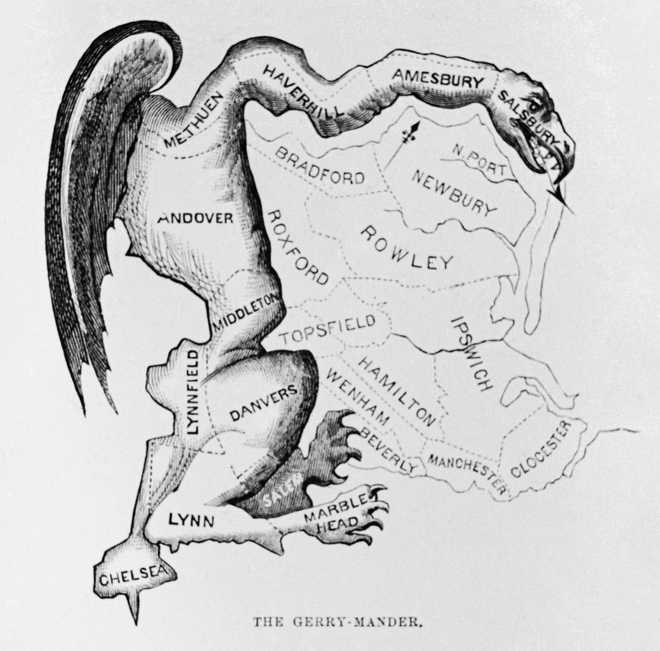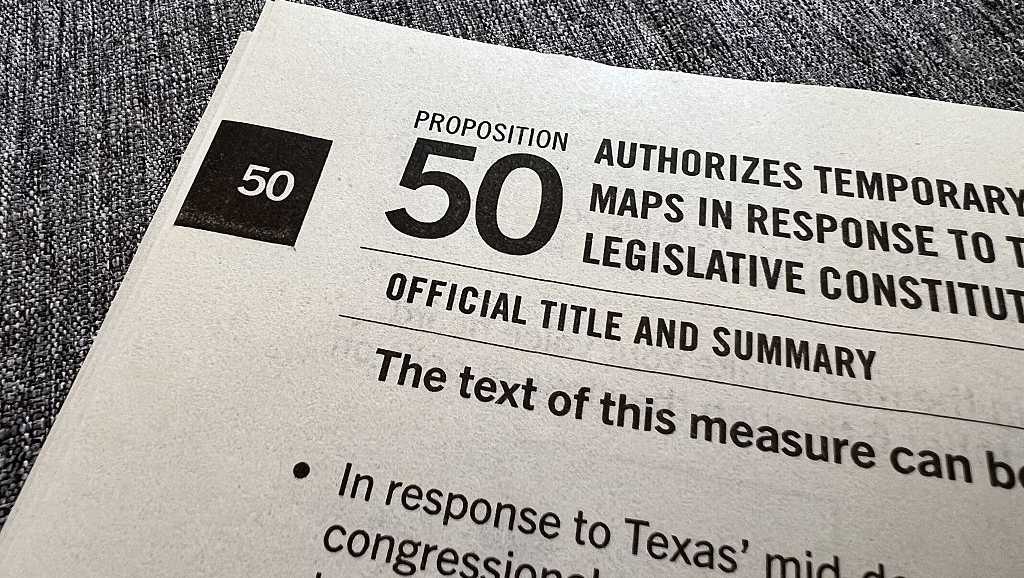Across the nation, several states are in a heated redistricting battle, in which lawmakers are redrawing congressional district maps to benefit either the Republican or Democratic parties. (Video Above: What California voters should know for Prop 50 special election)As each state makes national headlines with its redistricting pushes, you may have heard the term “gerrymandering.” So what is it?Gerrymandering is the process of manipulating electoral boundaries in order to favor one political party or class. “Elections are supposed to produce results that reflect the preferences of voters. But when maps are gerrymandered, politicians and the powerful choose voters instead of voters choosing politicians,” the Brennan Center for Justice explains. The origin of the word goes hand-in-hand with its history in politics. The Library of Congress says the term was first used on March 26, 1812, in the Boston Gazette, after a redrawing of Massachusetts State Senate election districts. The governor at the time was Elbridge Gerry, and although the redrawing was done under the Democratic-Republican Party, he signed the bill approving the maps. The ‘mander’ portion of the terms relates to how those districts looked. One of the remapped districts in the Boston area was said to resemble a salamander. The districts were “brought to life” as a mythical salamander or dragon in a political cartoon by artist Elkanah Tisdale. Proposition 50The latest redistricting push comes after President Donald Trump asked Texas to redraw their maps to bring five more Republicans to Congress in the 2026 midterm election.Because of that, Gov. Gavin Newsom and California’s Democratic leaders have fired back with a plan to send more Democratic representatives to Congress. But Texas and California’s situations are very different.In Texas, lawmakers in the state’s legislature have the power to redraw the maps, with approval from the governor. In a state that’s widely represented by Republicans, it was not a difficult feat. Gov. Greg Abbott signed the new maps into law on Aug. 29. In California, however, the congressional maps are decided by an independent commission. | RELATED | How we got here: A look back at Congressional redistricting in CaliforniaIn 2005, then-Governor Arnold Schwarzenegger began to campaign for an independent commission to draw the political boundaries, arguing that politicians couldn’t be trusted to draw their own districts.In 2008, Californians agreed, passing the Voters First Act. It created the California Citizens Redistricting Commission, the system the state currently uses to draw new districts for the State Assembly, State Senate, and Board of Equalization. And in 2010, the Voters FIRST Act for Congress expanded the commission’s role to include drawing congressional district lines.Normally, the map wouldn’t change until 2031, based on the next set of U.S. Census data that’s collected once a decade.So Newsom and other state Democratic leaders are working to get around that by putting forward Proposition 50. While the California Constitution prohibits lawmakers from drawing maps, a ballot measure could temporarily transfer that power.Prop 50 asks voters whether to use the new map for the next three congressional elections in 2026, 2028 and 2030.The latest national war over redistricting undoubtedly embodies the definition of gerrymandering, as the state maps are being redrawn to favor one party over another. California Democrats have argued that a difference with Texas is that ultimately voters will decide whether to adopt the maps. But one thing is clear— over the centuries, congressional districts have been redrawn in such unique ways that a salamander-shaped district is not so unusual. It’s unclear if the nation will ever return to a time when gerrymandering is rare.Learn more about Prop 50 from our previous coverage below:Special Election dates and deadlinesVoter turnout so far on Prop 50California Politics 360: A special report on redistrictingHow a USPS mail service change may delay ballot returns for rural votersEverything to know about Prop 50Who are the 5 California Republicans who could lose their congressional seat if Prop 50 passes?Get the Facts: Why do mail-in ballot envelopes have holes for Prop 50 special election?What is Prop 50? Arguments for and against the California redistricting measure See more coverage of top California stories here | Download our app | Subscribe to our morning newsletter | Find us on YouTube here and subscribe to our channelKCRA 3 Political Director Ashley Zavala reports in depth coverage of California redistricting efforts and other top policy issues on “California Politics 360.” Get informed with the latest updates about Prop 50 and more topics before Election Day on Sundays at 8:30 a.m. on KCRA 3.PHNjcmlwdCB0eXBlPSJ0ZXh0L2phdmFzY3JpcHQiPiFmdW5jdGlvbigpeyJ1c2Ugc3RyaWN0Ijt3aW5kb3cuYWRkRXZlbnRMaXN0ZW5lcigibWVzc2FnZSIsKGZ1bmN0aW9uKGUpe2lmKHZvaWQgMCE9PWUuZGF0YVsiZGF0YXdyYXBwZXItaGVpZ2h0Il0pe3ZhciB0PWRvY3VtZW50LnF1ZXJ5U2VsZWN0b3JBbGwoImlmcmFtZSIpO2Zvcih2YXIgYSBpbiBlLmRhdGFbImRhdGF3cmFwcGVyLWhlaWdodCJdKWZvcih2YXIgcj0wO3I8dC5sZW5ndGg7cisrKXtpZih0W3JdLmNvbnRlbnRXaW5kb3c9PT1lLnNvdXJjZSl0W3JdLnN0eWxlLmhlaWdodD1lLmRhdGFbImRhdGF3cmFwcGVyLWhlaWdodCJdW2FdKyJweCJ9fX0pKX0oKTs8L3NjcmlwdD4=
Across the nation, several states are in a heated redistricting battle, in which lawmakers are redrawing congressional district maps to benefit either the Republican or Democratic parties.
(Video Above: What California voters should know for Prop 50 special election)
As each state makes national headlines with its redistricting pushes, you may have heard the term “gerrymandering.” So what is it?
Gerrymandering is the process of manipulating electoral boundaries in order to favor one political party or class.
“Elections are supposed to produce results that reflect the preferences of voters. But when maps are gerrymandered, politicians and the powerful choose voters instead of voters choosing politicians,” the Brennan Center for Justice explains.
The origin of the word goes hand-in-hand with its history in politics.
The Library of Congress says the term was first used on March 26, 1812, in the Boston Gazette, after a redrawing of Massachusetts State Senate election districts. The governor at the time was Elbridge Gerry, and although the redrawing was done under the Democratic-Republican Party, he signed the bill approving the maps.
The ‘mander’ portion of the terms relates to how those districts looked. One of the remapped districts in the Boston area was said to resemble a salamander.
The districts were “brought to life” as a mythical salamander or dragon in a political cartoon by artist Elkanah Tisdale.

Proposition 50
The latest redistricting push comes after President Donald Trump asked Texas to redraw their maps to bring five more Republicans to Congress in the 2026 midterm election.
Because of that, Gov. Gavin Newsom and California’s Democratic leaders have fired back with a plan to send more Democratic representatives to Congress.
But Texas and California’s situations are very different.
In Texas, lawmakers in the state’s legislature have the power to redraw the maps, with approval from the governor. In a state that’s widely represented by Republicans, it was not a difficult feat. Gov. Greg Abbott signed the new maps into law on Aug. 29.
In California, however, the congressional maps are decided by an independent commission.
| RELATED | How we got here: A look back at Congressional redistricting in California
In 2005, then-Governor Arnold Schwarzenegger began to campaign for an independent commission to draw the political boundaries, arguing that politicians couldn’t be trusted to draw their own districts.
In 2008, Californians agreed, passing the Voters First Act. It created the California Citizens Redistricting Commission, the system the state currently uses to draw new districts for the State Assembly, State Senate, and Board of Equalization. And in 2010, the Voters FIRST Act for Congress expanded the commission’s role to include drawing congressional district lines.
Normally, the map wouldn’t change until 2031, based on the next set of U.S. Census data that’s collected once a decade.
So Newsom and other state Democratic leaders are working to get around that by putting forward Proposition 50. While the California Constitution prohibits lawmakers from drawing maps, a ballot measure could temporarily transfer that power.
Prop 50 asks voters whether to use the new map for the next three congressional elections in 2026, 2028 and 2030.
The latest national war over redistricting undoubtedly embodies the definition of gerrymandering, as the state maps are being redrawn to favor one party over another.
California Democrats have argued that a difference with Texas is that ultimately voters will decide whether to adopt the maps.
But one thing is clear— over the centuries, congressional districts have been redrawn in such unique ways that a salamander-shaped district is not so unusual. It’s unclear if the nation will ever return to a time when gerrymandering is rare.
Learn more about Prop 50 from our previous coverage below:
See more coverage of top California stories here | Download our app | Subscribe to our morning newsletter | Find us on YouTube here and subscribe to our channel
KCRA 3 Political Director Ashley Zavala reports in depth coverage of California redistricting efforts and other top policy issues on “California Politics 360.” Get informed with the latest updates about Prop 50 and more topics before Election Day on Sundays at 8:30 a.m. on KCRA 3.

